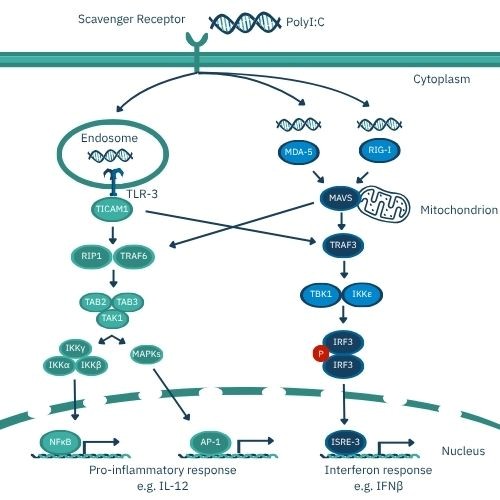Biosynth Antibodies: Powering Discovery
Discover how Biosynth’s antibodies are transforming the landscape of scientific discovery. From cancer research to immunology, antibodies offer a powerful tool to accelerate breakthroughs.
Biosynth supplies Poly I:C, a potent TLR3 agonist used as a vaccine adjuvant and in cancer research. Discover Biosynth’s solutions for immunotherapy and vaccine development.
Poly I:C is a synthetic double-stranded RNA analog, consisting of polyinosinic acid (poly I) paired with polycytidylic acid (poly C), forming a stable duplex structure. Its immunological effects vary based on molecular weight:
These findings, highlighted in Mian’s study, underscore the importance of choosing the appropriate Poly I:C type based on the cellular context and intended immunological outcome.
PolyI:C stimulates the secretion of pro-inflammatory cytokines and type I interferon through its interaction with endosomal Toll-like receptor 3 (TLR-3) and the cytoplasmic receptors melanoma differentiation-associated gene 5 (MDA-5) and retinoic acid-inducible gene I (RIG-I) (Figure 1).

| TLR-3 Pathway | MDA-5/RIG-1 Pathway |
|---|---|
| Recruit the adapter protein TLR adaptor molecule 1 (TICAM1) | Recruit the adaptor protein mitochondrial antiviral signalling protein (MAVS) |
| The pathways converge at the use of tumor necrosis factor (TNF) receptor-associated factors TRAF3 and TRAF6 | |
| TRAF6 and receptor-interacting serine/threonine-protein kinase 1 (RIP1) cause the phosphorylation of two downstream pathways by transforming growth factor (TGF)-β activated kinase 1 (TAK1). In the first pathway, the IKKα/β/γ complex releases NFκB, which enters the nucleus. In the second pathway, phosphorylated mitogen-activated protein kinases (MAPK) activates activator protein 1 (AP-1). NFκB and AP-1 produce pro-inflammatory cytokines and chemokines | As a result of TRAF3, TRAF family member-associated nuclear factor κ-light-chain-enhancer of activated B cells (NFκB) activator binding kinase 1 (TBK1), and inhibitor of NFκB kinase subunit ε (IKKε) form a complex which phosphorylates IFN regulatory factor 3 (IRF3) dimer. The IRF3 dimer enters the nucleus and binds to IFN-stimulated response element 3 (IRSE-3) This leads to the transcription of type I interferon. |
Poly I:C is widely recognized for its potent immunostimulatory properties, capable of activating immune cells both directly and indirectly. A key example is its ability to stimulate antigen-presenting cells, particularly dendritic cells, which are critical for initiating adaptive immune responses. Upon activation of intracellular signaling pathways, namely IRF and NF-κB, Poly I:C promotes the production of interleukin-12 (IL-12) and type I interferons (IFN-α/β). This, in turn, drives the activation of CD8⁺ cytotoxic T cells and Th1-polarized CD4⁺ T helper cells, which subsequently support B cell activation and antibody production.

Due to this mechanism, Poly I:C is frequently used in in vitro dendritic cell maturation protocols, where it has shown greater efficacy than other commonly used stimulants, such as TLR4 agonist LPS or pro-inflammatory cytokine cocktails.
In the context of influenza vaccines, Poly I:C has demonstrated the ability to elicit strong anti-hemagglutinin immune responses and enhance IgG isotype switching, contributing to improved protective immunity. Notably, a study by Le (2023) found that combining Poly I:C with monophosphoryl lipid A (a TLR4 agonist) significantly boosted antigen-specific antibody production and promoted robust memory T and B cell responses in mice. These findings highlight Poly I:C’s promise as a powerful adjuvant in next-generation vaccine formulations.
Poly I:C and its stabilized analogs (e.g., poly-ICLC) are being actively researched for their dual role in oncology: directly targeting tumors and acting as immune potentiators.

Enhancing CAR-T Therapy: In murine models of colon and breast cancer, combining Poly I:C with EGFRvIII-targeted CAR-T cells boosted cytokine release (IL-2, IFN-γ), reduced MDSCs, and improved tumor control – effects linked to type I IFNs (Di, 2019).
Gastric Cancer Apoptosis: Liposome-encapsulated Poly I:C induced strong apoptotic effects in gastric adenocarcinoma cells in vitro and significantly slowed tumor growth in mice. This apoptotic effect correlated with the upregulation of RIG-I, MDA-5, and LGP2 (Qu, 2013).
Poly I:C and poly-ICLC have also shown promise in cancer treatment across various clinical studies, demonstrating both safety and immune activation. In liver and pancreatic cancer trials, poly-ICLC combined with other therapies led to improved survival rates, enhanced immune responses, and tumor regression in some cases. Notably, it boosted natural killer (NK) cell activity and, in certain patients, triggered regression of both treated and distant tumors.
Biosynth can supply PolyI:C to all stages of your project – from R&D and preclinical phases right up to GMP commercial manufacture.
We have readily available long Poly I:C and can manufacture short Poly I:C on demand.
| Product Code | Poly I:C Product |
| J-030005 and OP29952 | Polyinosinic acid-polycytidylic acid, homopolymer (1:1) |
Contact our accountmanagers for custom Poly I:C products.
Whether you’re developing a novel vaccine or advancing cancer immunotherapy, Biosynth is here to provide the reagents and expertise you need
We gladly support you by keeping you updated on our latest products and the developments around our services.